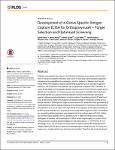Development of a Genus-Specific Antigen Capture ELISA for Orthopoxviruses – Target Selection and Optimized Screening
Stern, Daniel
Pauly, Diana
Zydek, Martin
Miller, Lilija
Piesker, Janett
Laue, Michael
Lisdat, Fred
Dorner, Martin
Dorner, Brigitte
Nitsche, Andreas
Orthopoxvirus species like cowpox, vaccinia and monkeypox virus cause zoonotic infections in humans worldwide. Infections often occur in rural areas lacking proper diagnostic infrastructure as exemplified by monkeypox, which is endemic in Western and Central Africa. While PCR detection requires demanding equipment and is restricted to genome detection, the evidence of virus particles can complement or replace PCR. Therefore, an easily distributable and manageable antigen capture enzyme-linked immunosorbent assay (ELISA) for the detection of orthopoxviruses was developed to facilitate particle detection. By comparing the virus particle binding properties of polyclonal antibodies developed against surface-exposed attachment or fusion proteins, the surface protein A27 was found to be a well-bound, highly immunogenic and exposed target for antibodies aiming at virus particle detection. Subsequently, eight monoclonal anti-A27 antibodies were generated and characterized by peptide epitope mapping and surface plasmon resonance measurements. All antibodies were found to bind with high affinity to two epitopes at the heparin binding site of A27, toward either the N- or C-terminal of the crucial KKEP-segment of A27. Two antibodies recognizing different epitopes were implemented in an antigen capture ELISA. Validation showed robust detection of virus particles from 11 different orthopoxvirus isolates pathogenic to humans, with the exception of MVA, which is apathogenic to humans. Most orthopoxviruses could be detected reliably for viral loads above 1 × 103 PFU/mL. To our knowledge, this is the first solely monoclonal and therefore reproducible antibody-based antigen capture ELISA able to detect all human pathogenic orthopoxviruses including monkeypox virus, except variola virus which was not included. Therefore, the newly developed antibody-based assay represents important progress towards feasible particle detection of this important genus of viruses.
Dateien zu dieser Publikation
Keine Lizenzangabe

